

Coral reefs are rapidly dying due to climate change and anthropogenic activities. Because these sensitive ecosystems are critical to ocean health, new approaches for designing synthetic reef systems have emerged in the last 50 years to sustain and promote coral diversity. However, despite their success, these studies lack the larger-scale and higher-level ecological analysis that accounts for anthropogenic threats to these ecosystems. Without considering how contemporary near-shore environments are hybrid, novel landscapes, artificial reefs are not designed for shared ecologies.
This study proposes a novel simulation framework that expands the existing analytical modeling methods, allowing us to visualize and test underwater eco-spatial phenomena within dynamic systems to better identify a design space for intervention with the goal of mitigating the conventional human-reef relationship through tactically choreographing sedimentation.
The simulation sequence proposes an overlay of (a) CFD analysis with (b) computational sand dune formation and (c) physical experimentation using a simulated sand and water table to study the sediment response to morphological intervention. The goal is to identify zones of intervention within the dynamic underwater landscape that encourage strategic increase or decrease of sediment build-up, nurturing coral health.


An example of a dying coral reef ecosystem is Hanauma Bay in Honolulu, Hawai’i. This is a location that is a popular tourist destination which is a large source of income to the economy of Hawai’i. Since opening up this beach for non-locals to visit, the coral reef ecosystem has begun to rapidly decay both because of the rising concerns with climate change and because of the impacts of recreational activities such as swimming, diving, and snorkeling.
These human-impacts have begun to become more apparent with the rise of COVID-19, disallowing visitors from coming to this beach as frequently as they have in the past. Current studies are showing that because of the lack of visitors, native fish that live within these coral reefs have started to come back out and the coral reef ecosystem has begun to slowly recover itself once again.
A site like Hanauma Bay with a large tourist population would benefit from an artificial reef-architectural system that would allow for not only the rehabilitation of its natural coral reefs and marine species, but also for the booming economic value that this site has for Oahu. an artificial reef system can be designed to help manage these reef habitats and maximize the benefits of marine life both for these marine species and for activities driven by tourism to create an environmentally-friendly urban environment that promotes ideas of education, recreation, and rehabilitation.

I looked into land building, floating architectures, and cave architecture precedents. Most of these projects are more focused towards coastal protection and its economic value while not necessarily thinking about the ecosystem and this kind of human-landscape of cohabitation So, how can we design hybrid architectural typologies that create these safe spaces for both humans and nonhumans to interact with one another through an artificial reef system?

These were some initial forms that I sketched out based on the zonal conditions that I planned on out site. The main concept of the site is to design pathways for humans and pathways for marine creatures, separated by artificial and natural coral reefs and these pathways would be formed from various simulation analyses that I conducted on the coral reef model.


Going into modeling the site and the coral reef, I began to model the site using bathymetric and topographical data, and then also began to 3d model these underwater habitats that exist within the sea but aren’t available in online databases for study.

Designing pathways for humans and pathways for marine creatures, separated by artificial and natural coral reefs. These pathways would be formed from various simulation analyses (sediment movement and fluid dynamics).

Through a series of simulation analyses using different mediums ranging from physical model testing to digital computational analyses, the goal of this circle of analysis is to understand how design can begin to reinforce these coral species based on the multiple patterns of protections obtained from these simulations and how digital and physical simulations can compare and support one another.
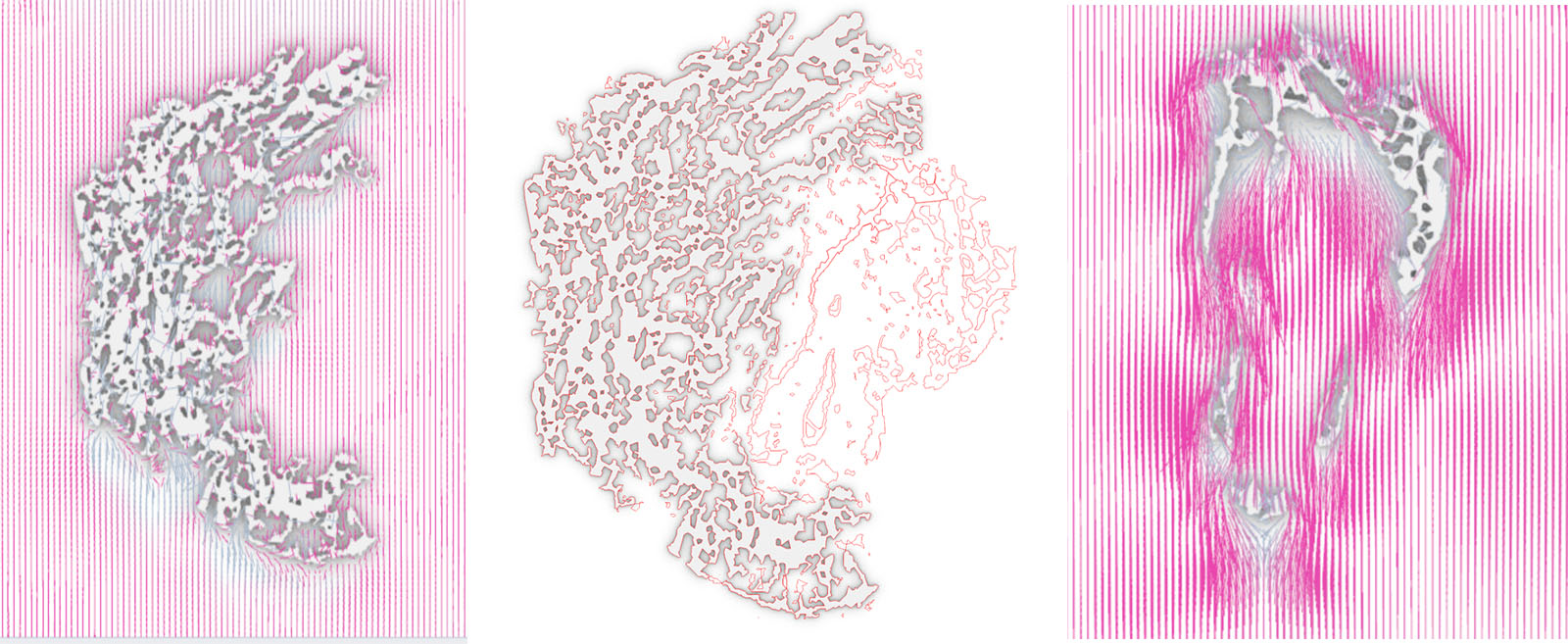
This test focused on figuring out how water forces acted on the existing coral form. I tested this using the regular conditions of wind speed, which averaged at 10.3 mph on site and seeing where water slowed down based on the coral form, which are the blue lines. The goal of this analysis is to analyze forms that create fast moving water and forms that were created from these slow moving forms, the shadows. Corals are known to thrive from fast currents and so this analysis can help create these forms to increase water speeds in specific areas of the bay, specifically in zones focused on rehabilitation.




An initial test was done on the site to test to see how the coral reef as a whole responded to the sediment movement. The goal of this analysis was to understand the potential spaces for sediment accumulation, which can begin to encourage vertical coral growth, which is a series of evolutions that corals have gone through to avoid trampling, specifically on sites that are highly populated by humans. However, this sediment accumulation would have to be mindful of the fact that too much sand could lead to coral suffocation. Careful design would need to be considered to maximize the benefits of sediment accumulation.



The two different simulation results on fluid dynamics and sediment movement were overlaid with one another to begin to understand how different shadows for new potential lands are created as a result of overlaps between where sediments can be accumulated and where slow or fast moving water is located. These would be areas where various artificial reefs could be placed to create new lands and safely encourage coral growth.
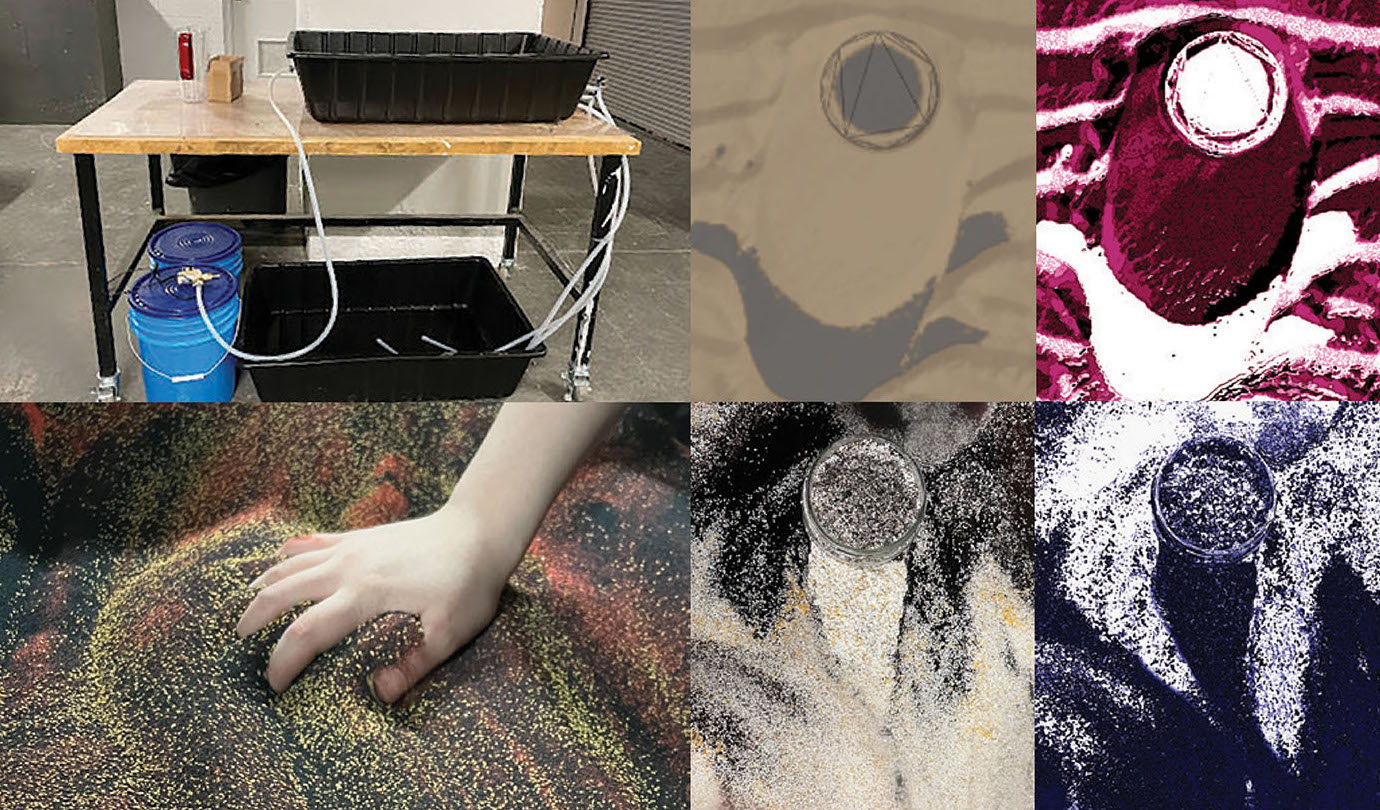

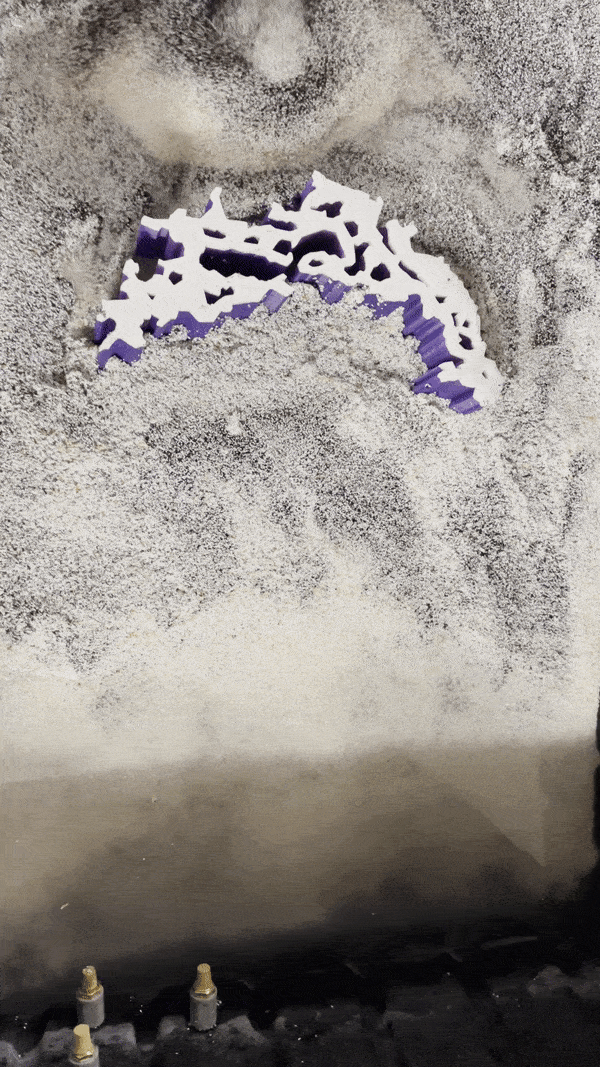

Color-coded media from emriver was used. This is a material that helps visualize water movement more clearly through its use of colored sediments at differing sizes, allowing for specific colors, such as black and red sediments, to be more easily seen with slower moving water because of their small size, and beginning to also move white or yellow sands with faster moving water.
After setting up the station, I was able to do a first attempt of applying water on the site to see how the sediments begin to move across the sand and just to test to see if the sand table worked.


The overlaps of the information begins to show the shadow of sediment accumulation potential that overlap between the two from the darkest areas (outlined in red), and it’s growth potential to the brightest areas, the flattest part of the simulation (outlined in green).

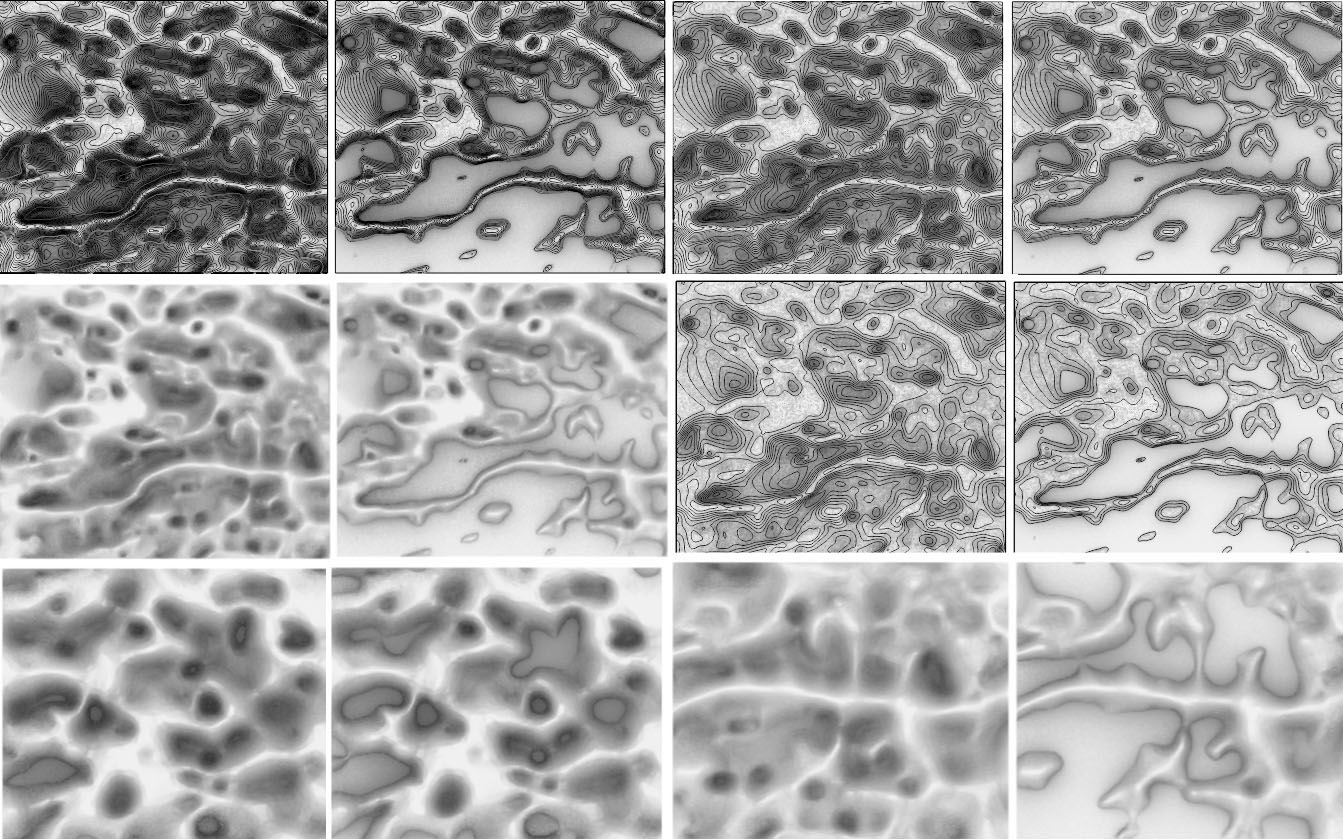

As a result of the simulations, various soft barriers and bridges to create multiple pathways to move around various species across the site and accumulate sand were designed to act as artificial reefs to encourage coral growth and a separator to protect fragile corals from human activities.
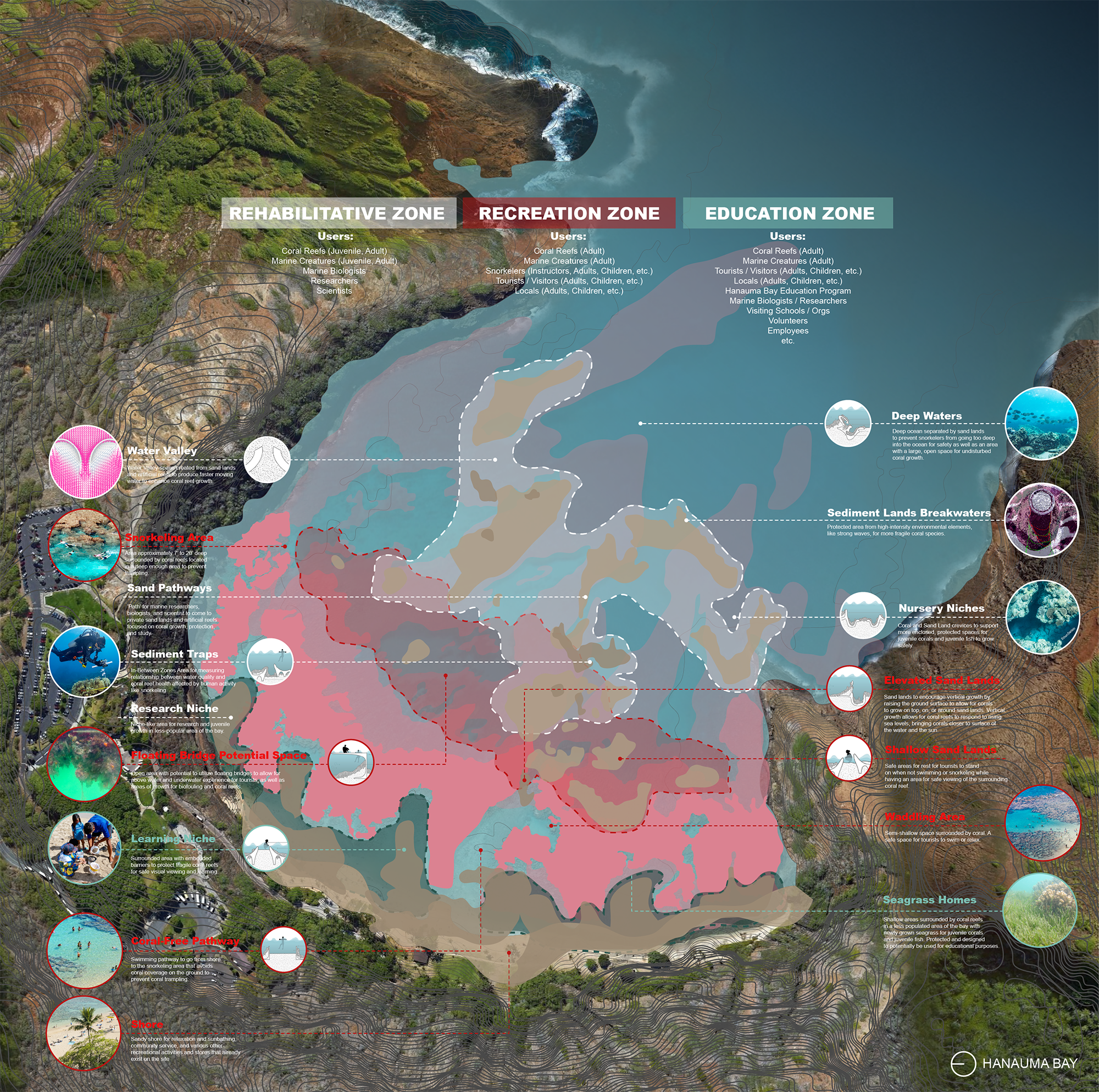
Finally, I concluded with looking at how these simulation results and proposed designs relate to the earlier proposed site zones. These are the different zones on site, the education and nursery zone on shore, the recreational zone, and the rehabilitative and nursery zone in deeper waters.
The first zone, the rehabilitative zone, is a zone mainly focuses on providing support to allow for the coral reef to continue to grow far from human use. This would be an area that is mainly inhabited by marine biologists, researchers, and scientists and would be a location that utilizes more “coral growth focused” artificial reef forms. Currently, various researchers are known to use the site for various tests such as sediment traps, which this location would allow for without any visitors interrupting the studies, as well as allow for researchers to help access these fragile nurseries for juvenile coral growth.
The next zone, the recreation zone, is an area solely focused on creating a safe environment for humans to coexist with the coral reef and marine creatures that inhabit the site. This would be a large snorkeling zone that would allow for humans to safely snorkel around or over coral reefs, utilizing these artificial reef barriers as a visual waypoint that informs passerbyers that coral reefs are incoming and to be careful of their actions while snorkeling. Around more fragile corals, soft barriers and bridges would be placed to begin physically separating humans from these more fragile coral reefs parts.
Last, the education zone is located on the shore and is mainly inhabited by human visitors. This zone enhances the existing educational programs that exist and visit the site and would mainly collaborate with the Hanauma Bay education program, by utilizing existing pockets of open sea floors made by the coral reef to create pockets of land and water that can be used as learning niches on site.
Overall, the goal is for these zones to create different types of interactions between multi-species and begin differentiating ways that both humans and marine nonhumans can interact with the site and with each other. The goal is to create a new idea of publics and privates, by creating more flexibility for marine creatures to choose what types of spaces they want to go to as well as creating safer environments for humans to begin to interact and learn from the coral reef on site through the use of soft artificial reefs.
In conclusion, the goal of this thesis is to utilize computational ecology with architectural approaches in design and fabrication to create forms that adhere to marine-rehabilitative and human-recreational needs and creating responsive architectures on a specific site that could potentially develop new methods of designing for these types of environments.

